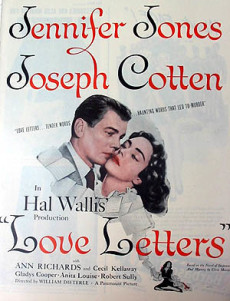
Hollywood On 52nd Street
Love Letters is a 1945 popular song composed by Victor Young with lyrics written by Edward Heyman. The song appeared, without lyrics, in the movie of the same name and was nominated for the Oscar for Best Song for 1945. The film starred Jennifer Jones, Joseph Cotton, Ann Richards, Cecil Kellaway, Gladys Cooper and Anita Louise.
The Story: The plot tells the story of American soldier Alan Quinton in Italy during WWII who has been writing letters for his friend Roger Morland to Victoria Remington, expressing feelings he could never say in person. Realizing she has fallen in love with him and that she will be disappointed in the real Roger, he abruptly leaves for paratrooper training in England. However, it is Alan who is falling in love with Victoria.
Injured, Alan discovers Roger and Victoria are both dead. Hereturns to England, spends time with his fiancé Helen Wentworth, lives at his aunt’s farm and is taken to a party by his brother. He meets Dilly Carson and Singleton, relates the Roger/Victoria story, Dilly realizes its Singleton and that the letters were somehow involved.
Singleton is actually Victoria, an amnesiac woman with two personalities, who killed his soldier friend, Roger. However, after spending time with her she realizes Alan is in love with her but not that she is Victoria. They marry after getting permission from her adopted mother, Beatrice Remington, bit the marriage is scarred by Alan’s love for Victoria.
Talking with Beatrice, Singleton begins to remember her abusive marriage to Roger and that it is Beatrice who stabbed him to death as Victoria attempts to save the letters thrown into the fireplace. Alan arrives at the house, Victoria recalls her true identity and they fall into each other’s arms.
Sponsored By
www.whatissuitetabu.com
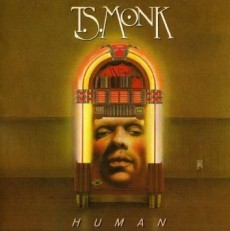
Daily Dose Of Jazz…
T. S. Monk was born Thelonious Sphere Monk, III on December 27, 1949 in New York City. He began his music career as a child when Max Roach gave him his first drum set before he turned 10. After graduating from school he joined his father’s trio touring with him until 1975. Leaving jazz for R&B, he toured with Natural Essence and then formed his own band with his sister.
By the 80s he was recording his debut album House of Music that charted several hits on Billboard, followed by the release of two more albums during the decade.
Shortly after his father died in 1982, in honor his father’s legacy and support the efforts of education, T. S. turned his attention toward forming the Thelonious Monk Institute of Jazz. As chairman, Monk has been at the forefront of helping to create a number of programs that range from sponsoring music education for students in the form of full scholarships to funding and supporting after-school athletic programs across the nation.
In the 1990s, Monk began his solo career taking a jazz-oriented direction and presented “A Celebration Of America’s Music” on ABC TV in 1996 and 1998 hosted by Bill Cosby and bringing together such artists as Natalie Cole, Jon Secada, Tony Bennett, k. d. lang, Herbie Hancock, Pat Metheny and Nnenna Freelon
T. S. has received the New York Jazz Awards First Annual “Recording of the Year” award and ‘Downbeat’s’ prestigious 63rd annual Album of the year Reader’s Choice Award for “Monk On Monk”. He continues in the tradition of creating great music as he performs, records and tours.
More Posts: drums,percussion
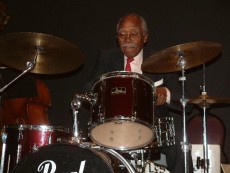
Daily Dose Of Jazz…
Butch Ballard was born George Edward Ballard on December 26, 1918 in Camden, New Jersey but grew up in Frankford, Pennsylvania. Following American Legion parades near his home, as a child he focused on the drummer and around 10 years old, his father bought him a set of drums. He took lessons for 75 cents each and continued his musical education Northeast High School in Philadelphia.
By 16 Ballard saw Herb Thorton, sat in and played and was invited to join a band by a man who heard him, and over the next few months rehearsed and played. In 1938, he started playing with Louis Armstrong’s band The Dukes, followed by stints with Cootie Williams, Ella Fitzgerald, Sarah Vaughan, Dinah Washington and Pearl Bailey.
Butch served in the Navy during WWII, then went to New York and worked with Eddie “Lockjaw” Davis, Eddie Vinson, Arnett Cobb and Clark Terry. He replaced Shadow Wilson in the Basie band in the late 1940s. The Fifties saw him touring Europe with the Ellington outfit and playing with Harry Carney, Paul Gonsalves, Billy Strayhorn, Kay Davis and Wendell Marshall. He declined the invite to join permanently because he didn’t want to change his drumming style to suit Duke, though he did record with him on such tunes as Satin Doll.
By the Sixties he was back in Philadelphia leading his own band and over the course of his career worked with the likes of John Coltrane, Harry “Sweets” Edison, Cat Anderson, Fats Waller, Lucky Millinder, Bootsie Barnes and Mercer Ellington among others.
In his later years he became a music teacher and played with the Philadelphia Legends of Jazz Orchestra and was honored with the Mellon Jazz Community Award for his continued education of young jazz musicians. Butch Ballard, who got the nickname after Machine Gun Butch, a character in the 1930 film The Big House, passed away on October 1, 2011.
More Posts: drums
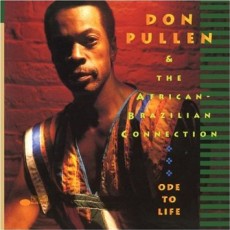
Daily Dose Of Jazz…
Don Pullen was born on December 25, 1941 and was raised outside Roanoke, Virginia and learned to play the piano at an early age. He played with the choir in his local church, was heavily influenced by his jazz pianist cousin, Clyde “Fats” Wright and took some lessons in classical piano. He knew little of jazz, concentrating mainly on church music and the blues.
Leaving Roanoke for Johnson C. Smith University in North Carolina to study for a medical career, Pullen soon realized that his true vocation was music. After playing with local musicians and being exposed for the first time to albums of the major jazz musicians and composers he abandoned medical studies for music.
By 1964 he was in Chicago with Muhal Richard Abrams, then moved to New York City and immersed in the avant-garde recording with Giuseppi Logan. Along with band mate Milford Graves formed a duo, started a small label and recorded his first sessions that did great in Europe. He turned to more profitable organ and during the 60’s and 70s played trio dates and backed such vocalists as Arthur Prysock, Irene Reid, Ruth Brown, Jimmy Rushing and Nina Simone. He held a brief position with Art Blakey and the Jazz Messengers in 1972.
Over the course of his career he would play with Charles Mingus, lead his own groups, form the George Adams/Don Pullen Quartet, put together the African Brazilian Connection, worked with Native American drummers and choir, and played with Nilson Matta, Carlos Ward, Gary Peacock, Tony Williams, Hamiet Bluiett, Bill Cosby, Jack Walrath, Maceo Parker, Roy Brooks, Jane Bunnett and David Murray among others.
Don Pullen jazz pianist, organist and composer of blues to bebop, who recorded over 30 albums as a leader and more than three dozen as a sideman, passed away of lymphoma on April 22, 1995.
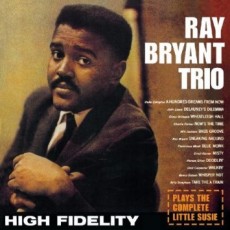
Daily Dose Of Jazz…
Ray Bryant was born Raphael Homer Bryant on December 24, 1931 in Philadelphia, Pennsylvania and began playing piano at age six. He played bass in junior High School. Turning professional before his age of maturity, he made a name for himself in his hometown playing a steady gig at the Blue Note Club.
From the late 1950s, he led a trio, performing throughout the world, and also worked solo. He recorded his first album with Betty Carter in 1955 titled “Meet Betty Carter and Ray Bryant” that marked his initial ascent. His first solo piano album “Alone With The Blues” in 1958 became the precursor to many more solo projects.
A noted jazz composer, with well-known themes such as “Cubano Chant,” “Monkey Business,” “Little Susie” and “The Madison Time,” the latter being resurrected in the 1988 movie Hairspray and subsequently used in the Broadway show.
Ray has performed and recorded with such players as Miles Davis, Sonny Rollins, Melba Liston, Coleman Hawkins, Charlie Parker, Carmen McRae and Aretha Franklin. Along with his brother Tommy and Oz Perkins he formed a trio as the back-up band in 1964 for the off-Broadway run of the comedy show Cambridge Circus starring John Cleese.
Ray Bryant, sensitive yet firm pianist who was comfortable with tonalities of gospel and blues and excelled as both sideman and leader passed away at age 79 on June 2, 2011.
More Posts: piano



